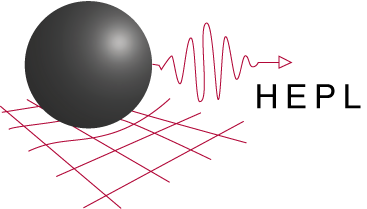HEPL KIPAC SeminarTuesday, September 26, 2006 4:00 – 5:30 pm Dr. Dan McCleese
|
Join our HEPL Seminar Mailing list!
Send an email to majordomo@lists.stanford.edu and type
subscribe heplseminars user@stanford.edu
in the body of the message where user@stanford.edu is your email address
You will receive an email confirmation. We hope to see you at a HEPL Seminar soon.
Previous HEPL Seminars 2004, 2005, 2006:
Dr. Dan McCleese
Chief Scientist, Jet Propulsion Laboratory
“Recent Results and Future Direction of the Exploration of Mars"
Tuesday, September 26, 2006
Ned Wright
Professor of Physics and Astronomy, UCLA
What's New in Cosmology?
Thursday 9 March 2006
Peter Michelson
Stanford University
GLAST: The Gamma-ray Large Area Space Telescope Mission
Seminar and Tour
Thursday 16 Feb 2006
Robert L. Byer
Stanford University
"Acceleration of Electrons with Visible Light"
Wednesday 1 Feb 2006
Dr. Nicholas White
Chief,
Laboratory for High Astrophysics NASA Goddard Space Flight Center
“The NASA Beyond Einstein Program”
Wed 5 Oct 2005
Ulrich Schreiber, Forschungseinrichtung Satellitengeodäsie, TU-München
“High Precision Sagnac Interferometry for Applications in Geoscience ”
Thursday, September 8, 2005
Christopher D. Bass,
Indiana University / IUCF, “Measurement of the Parity-Odd Neutron Spin Rotation in Liquid-4He”
Monday, August 22, 2005
Anne Kinney, Director, Universe Division in the Science Mission Directorate, NASA, "Blue Planets, Black Holes"
Wednesday, 20 July 2005
Dr William Tobin, Department of Physics & Astronomy, University of Canterbury, JNew Zealand, "Foucault's Gyroscope of 1852"
Friday, 8 April 2005
Rex Geveden, NASA Chief Engineer, Independent Technical Authority
7 April 2005
Shooting the Moon: Probing Fundamental Gravity in the Solar System
Tom Murphy,
UC San Diego 3 March 2005
The GRACE Mission: Status and Science Results John Ries, Senior Research Scientist at the Center for Space Research at The University of Texas at Austin, 14 February 2005.
Hubble Robotic Servicing - Recent Engineering Development, Bill Reeve
Civil Space Director of Advanced Science Programs,
Lockheed Martin, 26 January 2005.
Interferometry for LISA, Daniel Shaddock, PhD, Interferometry Metrology and Optics Group, Jet Propulsion Laboratory, 17 November 2004.
The Large Synoptic Survey Telescope (LSST), Steve Kahn, Deputy Director, Kavli Institute for Particle Astrophysics and Cosmology, 27 October 2004.
HEPL-KIPAC Showcase. 29 September 2004. Agenda


